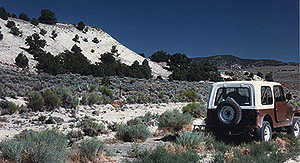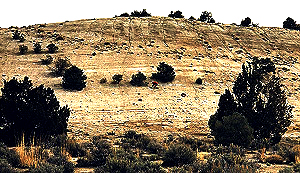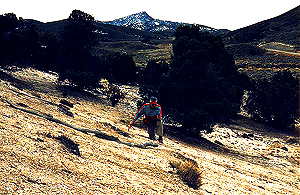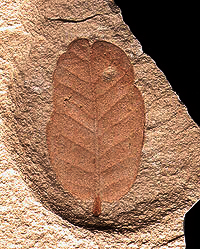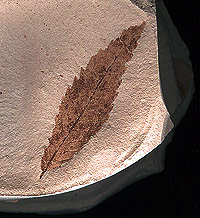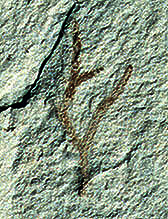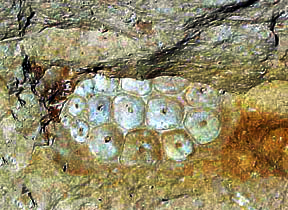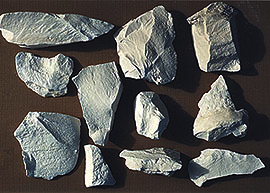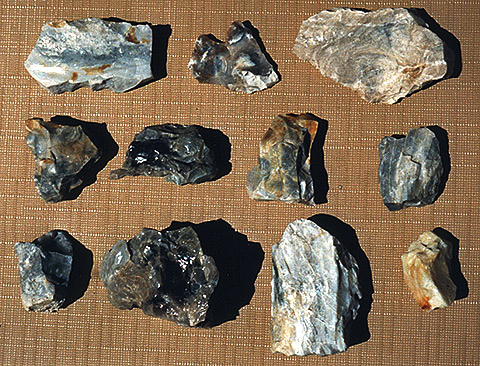|
Field Trip To The Buffalo Canyon Formation,
Nevada
The Buffalo Canyon Formation lies
in the heart of the arid Great Basin physiographic province a
number of miles from Fallon, Nevada, home to the US Navy's Top
Gun fighter pilot program. This is a land characterized by three
widely distributed botanic species: sagebrush, juniper, and pinion
pine. But roughly 15.5 million years ago, during middle Miocene
geologic times, the present-day fossil locality was the site
of a large fresh-water lake around which flourished a great variety
of plants, including but of course not limited to--spruce, fir,
pine, ash, maple, zelkova, willow, and evergreen live oak.
Today, common to
abundant carbonized leaf and seed impressions from over 50 species
of trees and shrubs, along with commercially mineable quantities
of diatomite (composed almost entirely of diatoms, a microscopic
photosynthesizing single-celled algae), can be found in the sedimentary
layers deposited in that ancient lake. Not only that, but several
diatomite beds in the immediate vicinity of the plant-bearing
locality have been changed to prized opal through the geologic
forces of heat and pressure, a geologic process that has created
abundant, colorful material for hobby, recreational lapidary
use.
All of the fossil
plants occur in the diatomite member of the middle Miocene Buffalo
Canyon Formation, a regional badlands-forming deposit originally
named by geologist K. L. Barrows in 1971.
Credit for discovering
the fossil plant-bearing beds at Buffalo Canyon goes to a Mrs.
Beulah Buckner, who came across the productive diatomaceous beds
during a rockhounding excursion in either the 1940s or very early
1950s. After she eventually directed writer Harold O. Weight
and his wife Lucile to the locality, Mr. Weight wrote up an article
on the subject of fossil plants in Buffalo Canyon for a noted
national publication, in which he named one of the primary
fossil-bearing sites Fossil Leaf Hill.
Interestingly enough,
many years later, completely unaware of Mr. Weight's earlier
published documentation of the Buffalo Canyon fossils, I happened
to re-discover that same leaf and seed-bearing locality and decided
to call it Fossil Leaf Ridge. Of course, probably loads of folks
have independently "discovered" that identical prolific
plant-yielding site over the decades.
The most efficient
way to locate fossil plants here is to split the soft shales
along their natural bedding planes. Use the pick end of a geology
rock hammer or a broad putty knife to split the poorly indurated,
often crumbly sedimentary material. If you should happen to accidentally
fracture a fossil specimen, use Duco Cement or some other fast-drying,
reliable glue to mend the break. But try to be especially careful
not to crack the fossils. Attempting to glue pieces of diatomaceous
shale back together is usually a messy, delicate chore. Several
coats of glue applied along the fractured surfaces may be required
to get the job done, since the porous, powdery rocks often soak
up glue like the proverbial sponge.
Not every sedimentary
rock layer in the area is fossiliferous--as a matter of fact
there appear to be many more barren horizons than plant-bearing
ones. But, generally speaking, if you can find the fine-grained,
whitish diatomaceous shales that outcrop in proximity to narrow
beds of blue-gray volcanic ash, your chances of finding superior
fossil plant specimens will increased dramatically. The "paper
shales" observed in parts of the section closely resemble
the plant and insect-bearing shales exposed in Fossil
Valley, Nevada, and Florissant, Colorado--noted
insect-yielding deposits of world-wide renown--although I've
yet to locate anything significant in the Buffalo Canyon sediments,
save for a few poorly preserved leaf fragments. Still, those
paper shales may well be worth some special explorations. Excellent
specimens could yet show up in them, due to the fact that they
lie in such close stratigraphic proximity to the plant-bearing
beds higher in the geologic section. Adding to the paper shales'
potential interest is the fact that, recently, a graduate student
on a field trip to Buffalo Canyon uncovered an exquisitely preserved
dragonfly wing--the very first fossil insect reported from the
middle Miocene Buffalo Canyon Formation.
The shales in the
Buffalo Canyon Formation grade upward into geologically younger
tan to gray clays and sandstones bearing five distinct beds of
lignite, a brownish-black coal whose alteration of the original
vegetal constituents has proceeded farther than in peat but no
so far as in subbituminous coal. All five layers of the lignite
have been analyzed for possible uranium content, but only two
of the beds showed any potential economic interest, averaging
0.052 to 0.1 percent uranium. The ashy-gray mudstones in this
part of the geologic section frequently yield abundant remains
of reeds from a species of cattail, a scouring rush.
Taken together
as evidence, the lignites and fossil cattails indicate ponded,
swampy conditions during deposition of the younger phases of
the middle Miocene Buffalo Canyon Formation. The regularly bedded
diatomaceous shales lower in the section--rocks which represent
the older periods of deposition--were likely laid down in a large
lake whose shoreline supported a dense growth of deciduous hardwood
trees and shrubs such as maple, birch, ash, cottonwood, willow,
serviceberry, hawthorn, Oregon grape, bitter cherry, currant,
rose, and sparkleberry. Slightly higher slopes bordering the
basin of deposition were covered by a rich mixed conifer forest
of fir, larch, spruce, cypress, hemlock, maple, alder, birch,
black locust, elm, zelkova, serviceberry, hawthorn, Oregon grape,
bitter cherry, and mountain ash. On the more exposed, drier south
and west-facing hillsides the mesic vegetation graded into an
evergreen woodland consisting of madrone, mountain mahogany,
cypress, stopper, juniper, catalina ironwood, and evergreen live
oak.
The Buffalo Canyon
fossil flora was most recently analyzed by the late paleobotanist
Daniel I. Axelrod in an informative monograph. Axelrod concluded
that the fossil floral association most closely resembles conifer-deciduous
forests now living in three widely separated areas of the United
States: the Klamath Mountains of northwestern California; the
Adirondack Mountains of eastern America; and the Porcupine Mountains
of Michigan.
Based on the environmental
preferences of modern analogs of the fossil flora, Axelrod decided
that precipitation in the ancestral Buffalo Canyon Basin was
approximately 35 to 40 inches per year, a figure that contrasts
radically with the scant 15 inches delivered there today--and
most of that amount is in the form of winter snow. A major difference
in the rainfall patterns 15.5 million years ago was that storms
dropped significant amounts of precipitation during both the
winter and summer months--enough rain during those seasons, as
a matter of fact, to account for such sensitive indicators as
elm, birch, hickory, black locust, and zelkova in the local fossil
record.
Temperatures were
also apparently much more moderate some 15.5 million years ago.
For example, terrain in proximity to today's fossiliferous Buffalo
Canyon Formation experiences an average June-July temperature
of some 77 degrees, but the associations of fossil plants now
found there prove that 15 million years ago the average monthly
reading for that specific time of season could not have been
any higher than 63 degrees. And while today's average January
temperatures range downward to a frigid, arctic-style 10 degrees,
the mid-Miocene plants demonstrate that 15.5 million years ago
a typical January mean would have been a rather chilly, but tolerable
37 degrees.
Such a major change
in Buffalo Canyon's precipitation and temperature averages over
geologic time suggests that elevations there differed significantly
some 16 to 15 million years ago. Cogitating this perplexing problem,
Axelrod studied in great detail the environmental requirements
for today's analogs of species found in the Buffalo Canyon Formation
to determine that the plants likely accumulated at an elevation
of roughly 4,200 feet; today, the fossil site lies at an altitude
of 6,060 feet, suggesting, according to Axelrod's analysis, that
the region has undergone an uplift of approximately 1,900 feet
since middle Miocene times 15.5 million years ago.
But, that was not
the end of the "uplift" story. Far from it. Eventually,
the late paleobotanists Howard E. Schorn and Jack A. Wolfe, along
with several other scientists working the problem independently,
applied sophisticated geophysical, geochemical, and Climate Leaf
Analysis Multivariate Program methodology (CLAMP) to conclude
that the present-day Great Basin region of eastern California
(Death Valley region), Nevada, southeastern Oregon, southern
Idaho, and extreme western Utah stood just as high, if not higher,
during middle Miocene times than it does today. Accordingly,
when all the evidence from disparate avenues of analysis finally
came together, Schorn and Wolfe proposed that the Buffalo Canyon
Formation plants accumulated at an elevation of roughly 9,000
feet, that in actual fact the entire Cenozoic Era Great Basin
region--the so-called Nevadaplano--had remained a vast high plateau
region for most of the early to mid Teriary Period (Paleocene,
Eocene, Oligocene, and lower to middle Miocene Epochs), until
at last that Nevadaplano gradually dropped, collapsed, to its
modern-day elevations by 6.8 million years ago through geologic
extensional stress and concomitant block faulting which helped
create the modern Great Basin geography.
Today, roughly
15 million years after Lake Buffalo Canyon ceased to exist, dried
up--a moment in geologic time before the Nevadaplano high plateau
completely collapsed--some 54 species of fossil plants remain
in the rocks to tell their fascinating paleobotanical tales.
The two most conspicuous, and abundant, forms encountered in
the Buffalo Canyon Formation are intact leaves from an evergreen
live oak, Quercus pollardiana--a species that is practically
identical to the living maul oak now native to the western foothills
of the Sierra Nevada, Cascade Mountains and Coast Ranges of California--and
leaves from a birch, Betula thor, whose vegetation is
identical to the modern paper birch. Other less commonly observed
specimens include the leafy twigs of cypress, a juniper, in addition
to the leaves of cattail, four species of cottonwood, six species
of willow, an alder, three additional species of birch, a hornbeam,
a hickory, a black walnut, two more species of oak, an elm, a
zelkova, two species of holly grape, a water lily, a hydrangea,
four species of currant, a Catalina ironwood, three species of
bitter cherry, a rose, a mountain ash, a leadplant, a black locust,
a tropical cypress, a madrone, a stopper, two species of ash,
a sparkleberry, and a snowberry. Also present, but rarely recovered,
are the winged flying seeds of two species of fir, one species
of larch, three species of spruce, two species of pine, one species
of Douglas-fir, one species of hemlock, and five species of maple.
During my last
extended exploration of the Buffalo Canyon Formation, I spent
a couple of productive days opening a modest-sized fossil quarry.
The digging was good. Among my keepers were several nice birch
leaves, winged spruce seeds, a few relatively rare Zelkova leaves,
and many nice evergreen live oak leaves. A few years later I
made a brief stopover to check out my quarry, which had lain
dormant all that time. Unfortunately, I found it had been obliterated
by heavy rains. All that was left to mark the site of my past
digs were several large slabs of shale I remember having yanked
out while attempting to expose a particularly fossiliferous layer
upon which were plastered some fine specimens of oak leaves.
The slabs of shale had been washed way down slope into a newly
formed natural gully far removed where I had dug--the result
of intense, short-lived rampaging runoff that had taken advantage
of the softer sedimentary rocks there, cutting into them with
potent ease: acts of inexorable erosive power on full display
here. I spent a couple of hours digging in the same general area
as my original quarry and was pleased to learn that the fossil
plants were still "alive and well;" they could still
be found there, much to my delight.
All of the collecting
sites are presently accessible: as far as I am aware, no federal
or private ownership collecting restrictions exist. Still and
all, conscientious fossil aficionados will nevertheless opt to
conduct common sense due diligence to determine the current legal
accessibility of the fossil locality before visiting. And, of
course, should commercial collecting parties begin to raid and
desecrate the fossil plant localities, the Bureau of Land Management
will most certainly close the fossil leaf-bearing district to
all but professional paleontologists.
It should be pointed
out, perhaps, that eventually, after several years of conducting
occasional visits to the much-productive district, I decided
to donate practically all the fossil plants I'd recovered from
the middle Miocene Buffalo Canyon Formation to a major museum's
archival paleobotanical fossil repository. As a general rule,
all particularly well-preserved plant remains collected from
the area should be brought the attention of a professional paleobotanist;
who knows, perhaps you have uncovered a species that is new to
science!
A field trip to Buffalo Canyon, Nevada,
will provide visitors with something out of the ordinary: a chance
to collect a large selection of nicely preserved middle Miocene
plant remains, plus an abundance of very colorful specimens of
common opal, as well. As you dig into the fossiliferous diatomaceous
shales of the middle Miocene Buffalo Canyon Formation, you will
bring fossil leaves and winged seeds to their first light of
day in some 15 million years, species which tell of a time when
the plant life in this part of arid Nevada resembled the modern-day
rain-rich Klamath Mountains of northwestern California and the
humid, moist forests of the Adirondack and Porcupine Mountains
of the northeastern United States.
|
